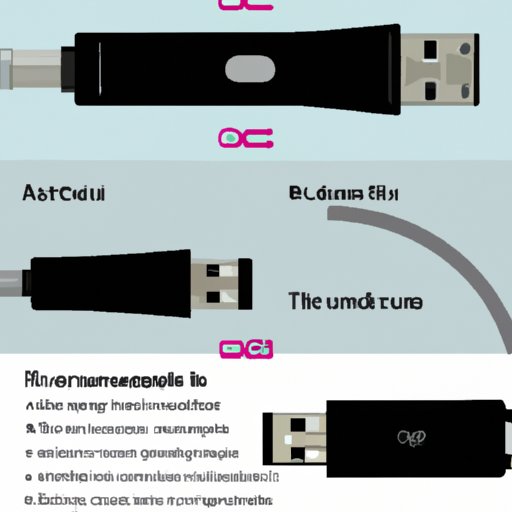Introduction
USB Type C is a newer version of the popular USB connector that has become increasingly popular in recent years. It was developed by the USB Implementers Forum (USB-IF) and is found on many devices, including laptops, smartphones, tablets, and other electronics. This type of USB connector offers several advantages over its predecessors, such as increased power, higher data transfer speeds, improved durability, and convenience.

Exploring the Advantages of USB Type C
The main advantages of USB Type C are its benefits for power and data transfer. With the increased power capacity, it can handle up to 100 watts of power, allowing for faster charging of mobile devices. In addition, data transfer speeds can be up to 10 times faster than traditional USB 2.0 connectors. This makes it ideal for transferring large files quickly.
Improved durability and convenience are also key advantages of USB Type C. The smaller size of the connector means it takes up less space, which makes it easier to fit into tight spaces. Additionally, the connector is reversible, so you don’t have to worry about plugging it in the wrong way. This helps reduce wear and tear on the connector, making it last longer.

The Basics of USB Type C Connectors
The anatomy of a USB Type C connector consists of two parts: the male and female ends. The male end contains a USB Type C plug, which fits into the female end’s receptacle. The male end also contains four pins that provide power and data communication between the device and the computer. This allows for faster charging and data transfer.
There are several different types of USB Type C connectors available. Some of the most common include USB 3.1, USB 3.2, USB Power Delivery (PD), Thunderbolt 3, and DisplayPort. Each of these connectors offer different capabilities, such as faster charging, higher data transfer speeds, or support for multiple video streams.
Comparing USB Type C to Other USB Types
When comparing USB Type C to other USB types, it’s important to consider the differences between USB 2.0 and USB 3.0. USB 2.0 offers slower charging and data transfer speeds than USB 3.0, which is much faster. USB Type C connectors are usually compatible with both versions of USB, although some versions only work with USB 3.0.
Another comparison to consider is between USB Type A and Type C connectors. USB Type A is the traditional rectangular-shaped connector, while USB Type C is the newer, smaller, and reversible connector. USB Type C connectors are becoming more popular due to their smaller size, increased power and data transfer speeds, and improved durability.
Common Uses for USB Type C
USB Type C connectors are used for a variety of different purposes. One of the most common uses is to charge mobile devices, such as smartphones and tablets. They can also be used to transfer files between computers and other devices, as well as connecting to monitors and displays. USB Type C connectors are also used for connecting peripherals, such as mice and keyboards.
How to Choose the Right USB Type C Adapter
When choosing a USB Type C adapter, there are several factors to consider. First, you should make sure the adapter is compatible with your device. You should also check to see if it supports the latest version of USB, such as USB 3.1 or USB Power Delivery (PD). Additionally, look for adapters that come with built-in surge protection and other features, such as overcharge protection.
Another factor to consider is the type of cable included with the adapter. Look for cables that are made from durable materials, such as nylon or braided fabric. Additionally, look for cables that are long enough to reach your device, but not too long that they become unwieldy.

Troubleshooting USB Type C Connectivity Issues
If you’re experiencing problems with your USB Type C connection, there are a few steps you can take to try and resolve the issue. First, make sure the connectors are properly plugged in and that the cable is undamaged. If the connections are good, then try unplugging and replugging the connector. Additionally, try using a different USB Type C cable or adapter.
If the issue persists, then it may be due to a driver issue or a hardware issue. In this case, you should contact the manufacturer of the device or consult a tech expert for assistance. Additionally, you can search online for guides and tutorials on troubleshooting USB Type C connectivity issues.
Conclusion
USB Type C is a versatile, powerful, and convenient type of USB connector that is becoming increasingly popular. It offers several advantages over traditional USB connectors, such as increased power, higher data transfer speeds, improved durability, and convenience. When selecting an adapter or cable, it’s important to consider compatibility, features, and length. Additionally, if you experience any connectivity issues, there are steps you can take to try and resolve them.


